Tag: mulch
Leaflet: Spring Tree Care
Spring has Sprung – What that means for your trees
Spring has truly come in fits and starts this year. Some of us might still feel like it’s winter, and some are ready to announce that Spring has sprung! Trees are the same way when it comes to breaking dormancy. Some are early risers, and some sleep in. A bunch of factors go into it, including species, daylight, and temperature.
Spring is the perfect time to notice seasonal cycles. The study of these periodic events in biological life cycles is called phenology. When does a tree go dormant, when do you start to see buds, how long is the growing season? We can see quite a range among species.
“Cornelian cherries normally bloom about this time of year,” says Neighborhood Trees Senior Specialist Andrew Land. “Whereas a few years back, someone approached me about an Oregon white oak that they thought was dead, until it finally broke bud in June.”
Andrew and other staff at Friends of Trees keep an eye on phenology as it particularly relates to survival. They take note of trends in trees’ responses to different stimuli like light and temperature, with the intent to prioritize the most climate adapted species.
Here are some things you can do to take care of your trees this time of year.
Mulch Madness
It’s a great time to refresh mulch as needed. The objective is to mulch the tips of the roots as they grow outward from the base of the trunk. They will grow into soil that’s moderate in temperature and contains moisture, factors that mulch will provide. Because the roots are growing outward, when you mulch trees in their second year in the ground, aim for more of a 4-5′ diameter ring of mulch, still 3” thick, about a foot from the base of the trunk.
You may have noticed that some trees hold their leaves through winter. They’re called marcescent leaves, and they are a sign of last season’s growth. You’ll see them on native oaks like Oregon white oak (Quercus garryana) and scarlet oaks (Quercus coccinea). Come spring time’s flush, these leaves will be shed to make room for new growth. You can use these leaves as mulch!
 Go easy on the pruning
Go easy on the pruning
It’s best to go easy with regard to pruning during “bud break.” This is when sap is rising up the tree, after having dropped to the roots in the fall. As the sap is rising, some trees (maples, for example) will “bleed” if pruned as sap is rising. It’s not harmful to the tree—that’s where maple syrup comes from, after all—but it can be disconcerting to see.
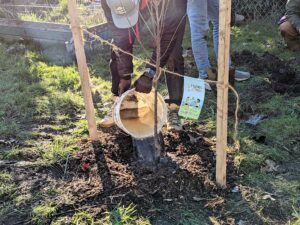
Weekly Watering
It’s almost time to start weekly watering for newly planted trees. “Deep and infrequent” is the recipe for success. Starting mid-April, 15 gallons all at once, once a week is ideal. Either a gator bag, hose on a gentle trickle for maybe 20 minutes, or a 5-gallon bucket with three 1/8″ holes drilled on the side at the bottom and filled 2-3 times consecutively works great.
If the temperature gets over 90 degrees, bump that up to twice a week. If we see another heat “event” coming, a good, deep soak beforehand is very wise as preventative medicine.
Leaflet – Watching the Seasons Change

You’re not the only one who’s noticing that the days are getting shorter. Our trees are noticing, too, and they’re taking it as a sign that the growing season is over. How do they notice? A hormone response is triggered by the shorter daylight hours, the angle of the sun, the cooler temps. This past month, you may have noticed a spring-like flush of herbaceous growth on your trees—one final push before autumn. That new growth will harden into woody material tough enough to survive our first frost in November.
Leaves on some deciduous trees will start changing color, a welcome sign of the cooler seasons after an especially hot summer. In a process called abscission, trees reabsorb the nutrients stored in the leaves before detaching and shedding them. Chlorophyll, which gives leaves their green color, is one of the first things to be absorbed, which is why we see them change color. But fallen leaves still have plenty of nutrients, which is why we encourage you to leave the leaves. Trees are putting those leaves there on purpose, to enrich the soil for their roots.
Most deciduous trees shed leaves in the fall. Some don’t though! Scarlet oaks, swamp white oaks, and many evergreens shed leaves in the spring as new growth emerges
For now, the best thing we can do is watch the weather, just like our trees are. Continue your watering regime until we’ve had one inch of rain in a week. After that, we’ll be out of the dry season and beyond the growing season when trees actively expand their canopies as they photosynthesize. And it happens to coincide with the timing for our trees to transition into winter dormancy, when their sap returns to their roots.
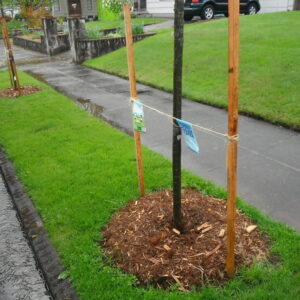
Roots can grow year round in the right conditions—moisture, air, and temperature—which is why we plant when we do, so trees can focus on establishing their roots. To help keep those conditions right for your young tree, make sure you replenish your mulch in the next couple months. One inch of mulch is a windbreaker, three inches is like a down jacket – and we want that year round, protecting against temperature extremes. Tree roots can grow 365 days a year as long as they have some moisture and a moderate soil temperature, both things that mulch provide.
This time of transition can be really exciting. It’s always remarkable to feel like summer is barely over, but by Halloween, which is now right around the corner, most of our trees will be dormant. As the seasons change, so do the needs of our young trees. So watch the weather, and stay tuned to Treemail for best practices for each season!
Get To Know ChipDrop

You know that we’re big fans of mulch at Friends of Trees, and we use a lot of it. That’s why we are so excited about our partnership with ChipDrop, an app that matches people who want free wood chip mulch with arborists and tree companies who are trying to get rid of it. Instead of taking wood chips to the landfill, arborists can drop them off right at your garden.
“We wanted to get involved with organizations that are on the same page,” says ChipDrop Co-Founder Andrea Kappa. “Friends of Trees is already in the business of educating people about the benefits of mulch, amending your soil, and growing what you want to grow.”
ChipDrop sponsored four Friends of Trees plantings this year. We picked plantings in neighborhoods that already had ChipDrop activity, so it was an opportunity to educate people about wood chip mulch that could be available to them.
“There are plenty of people who are on the fence about it or don’t understand it,” says ChipDrop Co-Founder Bryan Kappa. “Partnering on plantings is a great way to help people understand the benefits.”
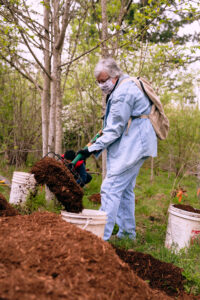
Think of what you can do with a truckload of mulch. “You can spread more than just a thin layer, and it will really amend your soil,” Bryan says. “So many people get frustrated that they can’t grow what they want to grow, and this is a way to do that.”
Beyond that, ChipDrop keeps material local and out of the landfill. If your neighbor has a tree taken down, that could become your wood chip mulch.
Of course, mulch is very important for newly planted urban trees. It reduces evaporation, delivers organic nutrients, and helps prevent the growth of weeds.
“Urban canopy is so important,” Andrea says. “Friends of Trees is taking huge leaps towards that. We’re super grateful for Friends of Trees as our first sponsorship. You’re such great supporters of what we do, and we foresee the partnership continuing into the future.”
Fall Tree Care
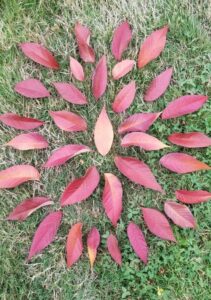
Leave the leaves!
Fall brings cooler days and evenings, an extra layer when we head out, and the striking colors on display gifted to us by nature. For many of us fall also means raking leaves–but it shouldn’t. In fact, fall tree care should include leaving the leaves!
We have this habit as a society to rake and dispose of leaves, but leaves are vitamins for plants and magic for building the health and vitality of soil. Throughout the growing season trees are producing energy in the form of sugar, or, sap. This time of year, as we start to see the leaves changing color, that’s the indication that the sap is crawling from the leaves, into twigs and branches, down the trunk and into the roots for winter.
When leaves fall, much of the tree’s energy, in the form of sap, goes into the root system encouraging new root growth (FOT gets busy this time of year very deliberately: planting trees now gives the roots a head start and a chance to anchor themselves). The rest of the leaf energy falls from the tree and settles on the ground–these leaves are literally vitamins for the root system that is primarily about 12-18” below the soil surface.
When we remove leaves we are actually interrupting a process called nutrient cycling, which is when the leaves break down and feed the roots. Rain carries the nutrients downward and provides them to trees and other plants water-solubly. So, leave the leaves! At the base of trees, in your garden beds, anywhere you want healthy soil in the spring.

Mulching: it’s not just for spring
Think about it: the forest floor is perfectly mulched. The act of transplanting a tree is unnatural, what we do planting trees doesn’t happen in nature, they don’t jump around and move. So, as tree stewards, we are trying to make trees feel comfortable, to restore a natural setting–as much as possible, of course, in an urban area. Street trees have it tough in this regard: They are often in compacted soil that is depleted, and it’s depleted because, unlike in the forest, we often remove leaves and clippings, and soil gets very compacted in the built environment.
So in addition to leaving the leaves, refresh mulch as needed. Create a “sacred mulched zone” ideally 2-3 feet in each direction from the base of the tree; this should be and remain a grass-free zone, and it should be an area that won’t be disturbed. If the tree is in a small space, such as a street tree next to the sidewalk, maintain it in the form of a square if there’s grass to mow since it’s easier to mow along a straight line than around a ring of mulch.
Why mulch? 50% of healthy soil is air & water pockets. How do we get these pockets? Partly through roots, just the process of roots growing down. And when some of the roots die and decompose they leave space in their wake, where fungi and bacteria grow and bring life to soil. Those fungi and bacteria grow where the soil isn’t, which is why compacted soil can be a challenge to bring to life.
When trees are transplanted – the most stressful day of a tree’s life – we want to foster new growth to set the new tree on the path of health and vitality. Tree roots can grow year round as long as the temperature of the soil is moderate (think of mulch as a down jacket for the soil) and there is the presence of moisture, both of which are provided by mulch! One inch of mulch is a windbreaker, three inches is like a down jacket – and we want that year round, protecting against temperate extremes. Not only is mulch insulating, it’s also thirst-quenching since wood chips hold water.
Fall tree care should start with building the soil with organic matter through application of mulch, setting the tree up for success, which is ever more important in a changing climate. Do take some time to get your mulching and non-raking done, and then tune in next month when we share the next stage of your fall tree care (hint: it rhymes with strewn, but don’t start yet!).
Check out our website for more tree care information and resources.
Our friends at Chip Drop are a great source for mulch, learn more here!
Tree care – we do that too!

Congratulations, you helped plant 50,000 trees and native shrubs last season! Now what? Good thing Friends of Trees isn’t just a tree planting organization–tree care is also on the list because we want the trees we plant to survive and grow and thrive.
It works.The survival rate for urban trees planted the Friends of Trees way, together, with guided post-planting care from our Tree Team, is 97% (based on Portland street trees planted last season). For the subset of trees we’ve been monitoring for nine years since planting it’s an 88% survival rate.
Our trees planted in natural areas also have strong survival rates, especially given some very challenging conditions; for example, some planting sites are not accessible for watering; some plants get eaten by wildlife; humans sometimes trample or vandalize; etc. Some studies indicate that an acceptable minimum survival rate for riparian area restoration plantings is 50%, so our survival rates of 81% in year one and 70% after three years are particularly impressive.
How do we help trees thrive?
We water. We prune. We mulch. We visit and assess. We do this for the street and yard trees planted through our Neighborhood Trees program as well as for the native trees and shrubs planted in our Green Space program.
As part of our Neighborhood Trees post-planting care, we:
- continually share information with tree-recipients about how much water, mulch and pruning trees need;
- deliver and apply free mulch soon after trees are planted;
- offer a summer watering service for a reasonable fee;
- have a Summer Inspector program where trained volunteers visit all newly planted trees twice in the first summer after planting to inspect for tree health, leaving tree care info for the tree recipient.
- have a longer term monitoring program where we visit subsets of trees planted anywhere from two to 10 years ago, to track health and growth;
- prune trees throughout the year (except for a few weeks in the spring and fall when trees are budding or dropping leaves). We rotate neighborhoods each year and focus most of our work on low income, low canopy and/or historically under-served communities.
Did we mention we prune? Last season we pruned more than 1,600 street trees, which is vital toward proper growth and really helps them survive wind, snow, and ice storms.
Our Green Space program also cares for the new trees and shrubs planted in natural areas, and we do this for up to 10 years after planting. The team is often joined by employee volunteer groups who help with summer maintenance tasks such as watering, mulching, and weeding (also called “day-lighting” since we’re clearing space around new plantings to provide for more light and air, and to reduce competition with weeds). We also assess for survival and replant when necessary.
Volunteers help with this! We train volunteers to inspect and prune trees, and volunteers are crucial to effectively mulching thousands of new trees at tree care events.
All told, we care for and monitor more than 54,000 trees a year!
We’re spreading the good word about trees.
We spend much of the summer spreading the word. Our Volunteer & Outreach Team, aided by dedicated Tree Team Ambassadors, attend events, festivals and fairs; plus, we have a crew of Canvassers who go door to door in priority neighborhoods. We strive to reach historically under-served, low-canopy neighborhoods with information about how to volunteer with us and how to get a tree from us. Interested in being a part of this? We’d love for you to join us.

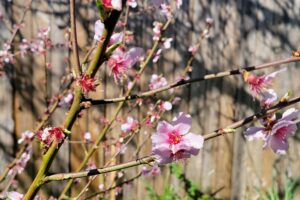
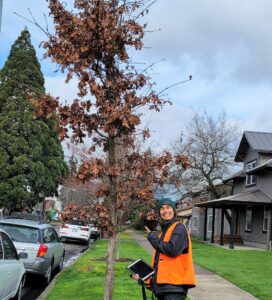 Go easy on the pruning
Go easy on the pruning